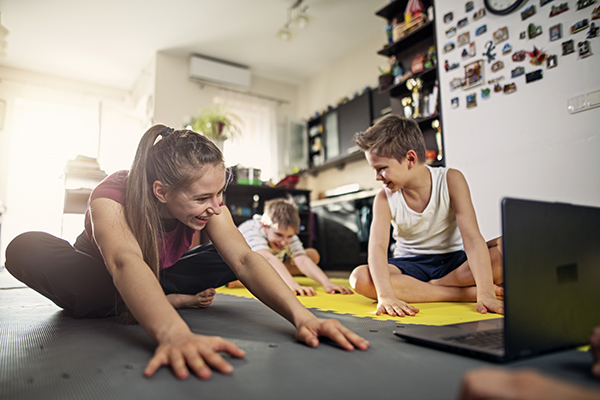6 Ways to Get Kids Fit – And Off Those Screens

From cell phones to video screens, computers to game consoles, my three boys could easily fill the entire day with tech time if I let them.
As an experiment one Saturday, instead of their regular hour of weekend tech time, I gave them unlimited screen time.
I figured they would play for a good three, maybe even four hours straight, but that eventually, they would grow weary of just sitting and staring and decide – all on their own! – to take a break.
I’m sure you can guess what happened.
I had good reason to hope — my boys love playing sports and would choose a day of boogie boarding at the beach over a day at the movies.
And still, they couldn’t self-regulate when it came to the call of the screen.
This is why it’s vital that parents get involved with helping kids make time to be physically active, says Rachelle Theise, PsyD, Clinical Assistant Professor and Child Psychologist at the NYU Child Study Center.
“Kids can’t be expected to get excited about exercise on their own,” says Theise. “They have to be encouraged by their caregivers who value and encourage physical activity.”
You can make being active a family affair with Double Time, Tony Horton’s family-friendly program on Beachbody On Demand.
Double Time includes 30 days of total-body workouts (all 35 minutes or less) that feel more like play and less like work. Anyone at any fitness level (ages 8 and up) can do this partner-focused fitness and nutrition program.
“If you want to connect with your child by doing Double Time together, but they have their face in their phone all the time, don’t make working out a punishment,” says Tony Horton. “Once they get going, they’ll see how fun the program is and your kids will look forward to it.”

According to the Centers for Disease Control and Prevention (CDC), children and adolescents should get 60 minutes or more of physical exercise each day, but many kids are falling far short.
In fact, the President’s Council on Fitness, Sports & Nutrition reports that only one in three children are physically active every day.
Kids now spend more than seven and a half hours a day (yes, a day!) in front of a screen including phones, TVs, videogames or computers. Yikes.
Yes, the prevalence of phones and tablets plays a role, but it’s not the only factor, explains Theise.
“With extended school days, an emphasis on after-school activities focused on academics, the lure of screen time, and parents’ own long work days, families are often left with little time and energy to prioritize exercise,” says Theise. “Physical activity can be seen as a luxury or an add-on to our busy lives, but it should be the opposite.”
Here’s how you help motivate your kids to put down those phones and fit in some fitness.
Tips For Motivating Kids To Get Fit
1. Monkey see, monkey do
Kids are watching us closely which means they’ll notice the hypocrisy if we tell them to go out and ride their bikes while we plop on the couch with the remote and a bag of chips.
Talk about why eating healthy and exercising are important to you – even if it’s something you struggle with – and how you find ways to fit it into a busy life.
“Parents can model their own enthusiasm for creating healthy habits and acknowledge how great it feels for their bodies to be working hard,” says Theise.

2. Make it fun!
Don’t make exercise seem like a chore. Helping kids get their heart rate up can be as simple as a bike ride to the park for a picnic, a game of H.O.R.S.E. on the basketball court, or a spontaneous dance party in the living room.
Use a stopwatch to time how long it takes them to run to the corner of the yard and back.
Use couch cushions and sheets to create an obstacle course that kids need to climb over, under and through. Or get silly.
Create stories with kids yoga poses, or let them create a funny workout video that you have to do together as a family.
3. Beyond the scale
While maintaining a healthy weight is important, focusing on their weight or BMI can often create a misguided understanding of exercise for kids. Instead, help kids see the benefits of fitness beyond the scale.
“Exercise promotes emotion regulation, positive coping skills for managing stress and anger, sleep, problem-solving skills, and happiness,” reminds Theise.
Talk about how exercise can help your child handle stress or frustration, and be sure to share your own workout benefits too like how a run helps you cope with a hectic workday or how fun it is to make new friends when you started tennis lessons.
4. Make it a family affair
Use exercise as a family time two-fer: time together for heart-to-heart talks AND time getting your heart rate up.
“It’s great if families can exercise together, like going for a family bike ride or mystery walk, playing tennis or basketball together, or rollerblading in the park,” recommends Theise.
Find fun fitness opportunities you can do together as a family or look for ways to add in exercise to your normal family to-dos like walking to the store instead of driving or taking the stairs instead of the elevator.

5. Find a sport
Sports are another great way to add exercise into your child’s week. The key is finding the right fit for your child, says Theise.
“Often, outgoing, social kids do well on team sports like basketball or soccer, and shy, quiet kids feel more comfortable in individual sports like tennis, swimming, or running,” she adds.
Sports do a lot more than just provide exercise, too. They give kids opportunities learn about teamwork, resilience, grit, coping skills, and mental strength, says Theise, all vital skills to learn and utilize as they get older.
6. Try a tracker
Just like many adults, some kids may not be aware of how little they are moving each day.
Consider a kid-friendly fitness tracker like the Garmin Vivofit Jr. or Fitbit Zip to help your child see how many steps a day they are getting and motivate them to meet movement goals.
Create a weekly family step objective with a healthy reward at the end.
Real Parents Report: Screen Time Vs. Exercise
Any parent will tell you – the screen-time struggle is real.
Here’s how four families are helping their kids find balance between tech and time being physical:
“My son and I started waking up 25 minutes earlier in the morning. We jump rope, dance, play basketball, and on Fridays we ride bikes to school. The day gets so busy after school that it’s been better when we start off with exercise. As an added bonus, he is more focused now that we work out prior to school.” — Deborah K.
“I think keeping them active is the key to keeping them from being bored and starting unnecessary arguments. My kids play baseball during spring and into summer, and then soccer in the fall. They earn screen time by the hours of play they have done during the week. A day of practice means an hour of screen time during the weekend.” — Amber V.
“One of my sons is not that interested in sports, so I got all of us new bikes and we started biking to school more just to add some activity. Any organized sport he would shoot down, but this he loves because I let him go ahead once we cross the big street together and he feels independent.” — Rachel S.
“We got a trampoline and now my kids are outside jumping even in the rain!” — Jody A.
Check out the Beachbody Kids and Family collection on Beachbody On Demand — these are workouts specifically selected for you to do with your family!
